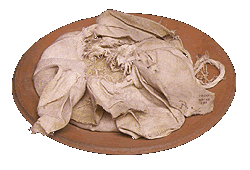| Egyptian Afterlife | Daily Life |
Embalming the Body
First, the body is taken to the tent known as 'ibu' or the 'place of purification'. There the embalmers wash the body with good smelling palm wine and rinse it with water from the Nile. The priest burned incense to sweeten the air while they prepared the mummy, working as quickly as possible.
One of the embalmer's men makes a cut in the left side of the body with a flint knife and removes many of the internal organs. It is important to remove these because they are the first part of the body to decompose.
The liver, lungs, stomach and intestines are washed and packed in natron, which will dry them out. The heart is not taken out of the body because it is the center of intelligence and feeling and the man will need it in the afterlife.

To remove the brain, an iron hook was pushed through a nostril and rotated vigorously for 20 minutes. This broke up the brain, turning it into a glue-like substance that could be drained out through the nose. The skull was then turned over and washed out with preservatives.
 natron
natron
The body is now covered and stuffed with natron, which will dry it out. All of the fluids and rags from the embalming process will be saved and buried along with the body.
After forty days, during which time the body has lost about 75 percent of its weight, it is then washed again with water from the Nile and covered with oils to help the skin stay elastic.
The dehydrated internal organs are wrapped in linen and returned to the body. To restore its natural shape, the body is stuffed with dry materials such as sawdust, leaves and linen so that it looks lifelike.
Finally the body is covered again with good-smelling oils and artificial eyes are inserted into the skull. It is now ready to be wrapped in linen.
Bandaging the body was a religious ritual that took 15 days. The linen bandages, often made from old clothes, were soaked in resin to stiffen them.
Protective amulets or charms were placed on the body in key places such as the heart and wrapped up with bandages.
In the past, when the internal organs were removed from a body they were placed in hollow canopic jars (also referred to as visceral jars).
Over many years the embalming practices changed and embalmers began returning internal organs to bodies after the organs had been dried in natron. However, solid wood or stone canopic jars were still buried with the mummy to symbolically protect the internal organs.
 Imsety,
the human-headed god, looks after the liver.
Imsety,
the human-headed god, looks after the liver.
 Hapy, the baboon-headed god, looks
after the lungs.
Hapy, the baboon-headed god, looks
after the lungs.
 Duamutef, the jackal-headed god, looks after the
stomach.
Duamutef, the jackal-headed god, looks after the
stomach.
 Qebehsenuef, the falcon-headed god, looks after the intestines.
Qebehsenuef, the falcon-headed god, looks after the intestines.
DID YOU KNOW: Canopic jars used to store a mummy's internal organs, are named after the local god of Canopus, a town in the Nile delta region. He was represented as a human headed pot.
Securely tied with hundreds of metres of bandage, and protected with magic charms, the body was now a suitable residence for the eternal Ka.
In the last years of ancient Egypt, lifelike representations of eyes that were made from gold leaf were placed over the eyes-sockets of corpses.
The priest in charge of the embalming process wore a jackal mask that symbolised Anubis, the god of the dead and of mummification.
DID YOU KNOW: Most mummies wore make-up, some even had their hair done for the afterlife.
| Egyptian Afterlife | Daily Life |